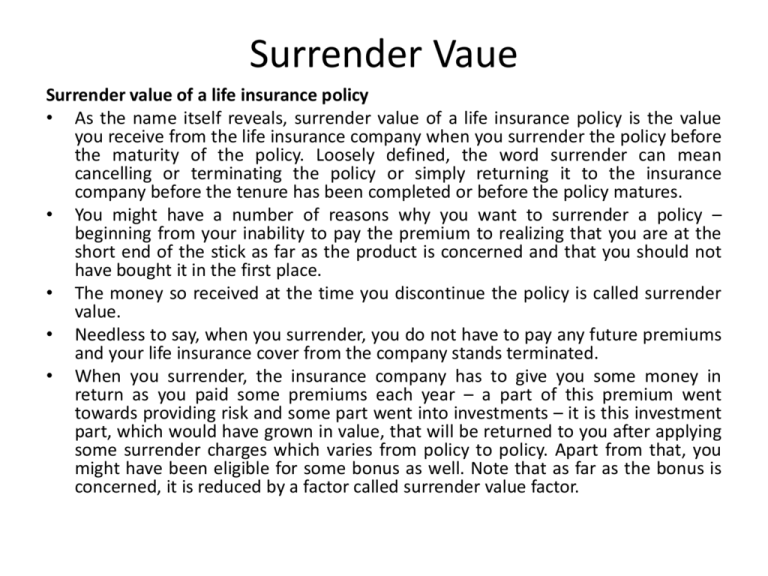
As a consequence, for financial statement purposes the computer will be depreciated over three years. The general ledger account Accumulated Depreciation will have a credit balance that grows larger when the current period’s depreciation is recorded. As the credit balance increases, the book (or carrying) value of these assets decreases.
Machinery and equipment
If you only need some of your cash value, you could take a partial withdrawal. This maintains your life insurance and whatever cash value is still in the policy will continue to grow. If you withdraw your cash value gains, you would owe income tax on the gains. The process starts when a third party solicits insurance agents or financial planners to find patients with AIDS or other terminal illnesses who are willing to sell their policies in return for an immediate cash payment. The third party determines how much to charge investors for each policy.

Which policies have a cash surrender value?
FASB argued in the technical bulletin that there is no justification to support recording insurance contracts at amounts other than agreed amounts (such as cash surrender value). Furthermore, the cash flow statement may reflect the impact of premium payments made towards the life insurance policy. These payments are recorded as cash outflows from operating activities, which can affect the company’s net cash provided by operating activities.
Hello and welcome to Viewpoint
This inclusion can enhance the company’s financial position, potentially improving liquidity ratios and overall financial stability. Investors and stakeholders often scrutinize these ratios to assess the company’s ability to meet its short-term obligations and long-term financial health. When a corporation holds a life insurance policy, the cash surrender value represents the amount the company would receive if it decided to terminate the policy before the insured event occurs.
Intangible assets
This involves obtaining periodic statements from the insurance provider, which detail the current surrender value. Any discrepancies between the recorded value and the actual value must be reconciled promptly. This ensures that the financial statements present a true and fair view of the company’s assets. Don’t overestimate your cash surrender value, which is not reflective of the amount of coverage you have taken out for the death benefit. A cash value is tied to the policy as a benefit to help offset the rise in premiums as you grow older and offers policyholders access to money they can borrow. A cost that has been recorded in the accounting records and reported on the balance sheet as an asset until matched with revenues on the income statement in a later accounting period.
If you want to increase your cash surrender value on your life insurance policy, there are a few things you can do. First, you’ll want to make sure you’re fully understanding your policy and what’s allowed under it. Second, you’ll need to understand how the cash surrender value is calculated and what factors can affect it. Lastly, you’ll need to make sure you’re meeting all of the eligibility requirements to increase your cash surrender value.
First, any asset amount on the balance sheet is limited to the policy’s cash surrender value. The tax implications of cash surrender value in corporate finance are multifaceted and can have significant consequences for a company’s tax strategy. When a corporation holds a life insurance policy, the premiums paid are generally not tax-deductible.
- If a policy has a cash surrender value, the purchaser’s cost will undoubtedly exceed this amount, resulting in a sizable loss for financial reporting purposes on the acquisition date.
- The advantages of the investment method are reduced volatility of income measurement, more realistic asset valuation and ease of implementation.
- With universal and variable life insurance policies, cash values are not guaranteed.
- Therefore, the recorded amount of goodwill is not amortized to expense.
- For example, a computer might physically last for 100 years; however, the computer might be useful for only three years due to technology enhancements that are occurring.
The insurance company could deduct a fee before paying out the cash value, known as a surrender charge. One advantage of buying permanent life insurance is that it offers both a death benefit and a savings component called cash value. If you no longer need life insurance — say, because your children are cash surrender value of life insurance balance sheet classification grown and financially independent — you can cash out the policy. The cash surrender value is the money you’ll receive after terminating a permanent life insurance policy. Though the cash surrender value method is easy to apply, its economic soundness is subject to criticism for two primary reasons.
This is what your insurance company would pay you if you wanted to cancel your policy before it expired. In many cases, it is possible to use the cash value in your account to pay your premiums. By doing so, you keep the coverage in place for your beneficiaries.
Leave a Reply